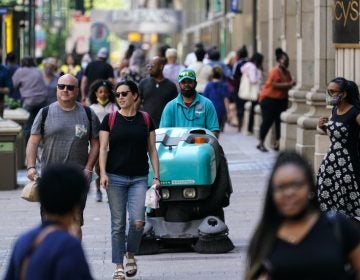Graphic-novel author aims to educate Germantown about decaying urban spaces
Philadelphia-based author Aaron Birk’s graphic novel “The Pollinator’s Corridor” is a study in contrasts.
Color coexists with shadow. Hard science is interlaced with elements of myth and mysticism. Pastoral imagery abuts gritty street scenes. The past, present and future converge simultaneously on pages that suggest man’s impact on the environment, blending charged rhetoric with poetic passages that reveal the emotional interior of the characters.
The result, said Birk, is a multi-layered story where “hope and cynicism blend together.”
Green reclamation
The title “Pollinator’s Corridor” refers to a process wherein decaying urban spaces are transformed into green, natural expanses through deliberate acts of planting and waterway reclamation.
Original funding for the project was provided by a Kickstarter grant, with additional resources being provided by The Independence Foundation, the Greater Philadelphia Cultural Alliance, and the New York Foundation for the Arts.
The self-published book was released on March 3; about half of the original 1,500-copy run has been sold to date.
A Germantown influence
While much of the book’s action takes place in New York City — with maps and images and references to indicate this – in actuality, much of the book is another city in disguise.
“Deep down,” said Birk, “it’s actually Philadelphia dressed-up.”
A rendering of the Divine Lorraine intimates the Philadelphia connection, but Birk said that many of the scenes in the book indeed derive from local neighborhoods.
The Germantown neighborhood informs much of the book.
Once a week, he teaches fourth-graders at Project Learn about environmental issues.
In addition, a close friend who was raised in Germantown figured prominently in Birk’s relocation to Philadelphia in 2005.
Charmed by the feel of the city, it was Philly’s oasis-like qualities that encouraged Birk to plant roots in community. When compared to New York, Philadelphia’s artistic climate and verdant qualities encouraged him to stay.
“Philadelphia is a much more successful example of the ‘pollinator’s corridor,'” he said.
By hand, not computer
The story, he said, came in a relative flash in 2003, with the illustrations hewn from the following eight years.
Comparing the relative time needed for pictures versus plot, Birk remarked, “It’s the tragedy of the graphic novel.”
The central technique replied upon was collage, calling on a variety of papers and pens — and, he noted, a lot of little pictures pasted together — to build a book that, in his words, derives its dynamicism from the mediums themselves.
Birk is quick to point out that all the imagery was done by hand, and that the book was produced lithographically.
“No Photoshop,” he said, “and no computers,” the lone exception being the page numbers.
For his research, Birk delved into archival photographs and historical documents to inform his illustrations. While accuracy was a consideration, he felt limited trying to represent the present.
“I felt that I had more freedom with the past,” he said.
What’s next?
The current edition of “Pollinator’s Corridor” is volume one, and Birk plans to complete the next installment by July. He said he expects it to hit the streets in August.
He related plans for an eventual expansion of the series into individual chapters, all concluding with cliffhangers, a tribute to the serial comics that Birk holds in high regard.
But don’t expect the volume to be available digitally; Birk is reluctant to lose the tangible aspects of the printed form.
“There’s a permanence to a printed book,” he said, adding that refrains lamenting the death of the publishing hold little truck with him. “I see it as being an ideal time for small publishers.”
****
With teachers and students at Project Learn School, Birk‘s graphic novel will serve as a launching point for students who will survey and map their neighborhood, identifying “gaps” in pollinator habitat, and create a real-world ‘Pollinator’s Corridor’ through the heart of Germantown.
Students will engage in “guerilla gardening” and “seed bombing” projects throughout the areas surrounding their school to connect the Wissahickon Valley with Awbury Arboretum and other fragmented habitats.
WHYY is your source for fact-based, in-depth journalism and information. As a nonprofit organization, we rely on financial support from readers like you. Please give today.




